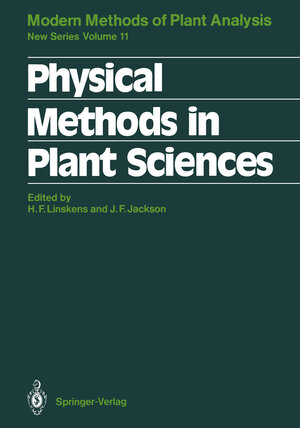
×
![Buchcover ISBN 9783642836114]()
Inhaltsverzeichnis
- Laser—Doppler Vibrometer Measurements of Leaves.
- 1 Introduction.
- 2 Materials and Methods.
- 3 Two Simple Models for Vibrating Leaf Tissue.
- 4 Experiments and Results with Clamped Leaves.
- 5 Experiments and Results with Free Hanging Leaves.
- 6 Discussion.
- References.
- Triplet States in Photosynthesis: Linear Dichroic Optical Difference Spectra via Magnetic Resonance.
- 1 Why Triplet States Are of Interest.
- 2 Information Obtainable from ODMR Spectroscopy.
- 3 Applications of ODMR in Photosynthesis.
- 4 Conclusions and Prospects.
- Laser Physical Methods: Laser Microprobe Mass Spectrometry.
- 2 Historical Survey.
- 3 Instrumentation.
- 4 Specimen Preparation.
- 5 Features of the Instrument.
- 6 Experimental Parameters of Different Groups.
- 7 Ion Formation Mechanisms and Characteristics of Spectra.
- 8 Efficiency of Different Microprobe Methods.
- 9 LAMMA Applications, Inorganic Ions.
- 10 LAMMA Applications Organic Compound Analysis.
- 11 Stable Isotopes as Markers.
- Fast Atom Bombardment Mass Spectrometry.
- 1 Introduction to Fast Atom Bombardment Mass Spectrometry.
- 2 Quantification and Stable Isotope Analysis of Quaternary Ammonium Compounds.
- 3 Quantification and Stable Isotope Analysis of Amino Acids.
- 4 Analysis of Oligosaccharides.
- 5 Analysis of Polypeptides.
- 6 Analysis of Glycoproteins.
- 7 Nucleotide Analysis.
- 8 Structural Characterization of Miscellaneous Secondary Plant Products.
- 9 Concluding Remarks.
- 10 References.
- Microdissection and Biochemical Analysis of Plant Tissues.
- 2 Freeze Stop.
- 3 Storage of Frozen Tissues.
- 4 Freeze-Drying.
- 5 Sample Containers.
- 6 Storage of Freeze-Dried Material.
- 7 Dissection of Tissue.
- 8 Determination of Sample Mass.
- 9 Biochemical Analysis of Samples.
- 10 Example for theComplete Procedure: Determination of Fumarase Activity.
- 11 Examples for Application: Intercellular Compartmentation of Physiological and Biochemical Properties in Plant Tissues.
- 12 Final Remarks.
- Photoacoustic Spectroscopy — Photoacoustic and Photothermal Effects.
- 2 Physics of the Photoacoustic Effect.
- 3 Measuring Systems.
- 4 Applications in Plant Analysis.
- 5 Further Development.
- Membrane Operational Impedance Spectra of Plant Cells.
- 2 The Laplace Transform.
- 3 Measuring Techniques.
- 4 Data Analysis Technique.
- 5 The Concept of Membrane Capacitance.
- 6 Conclusion.
- Image Instrumentation Methods of Plant Analysis.
- 2 Image Sensor Selection and Processing System.
- 3 TV Spectral Image Instrumentation.
- 4 Remote-Control Light Microscope System.
- 5 Image Instrumentation of Chlorophyll Fluorescence Transients.
- 6 Thermal Image Instrumentation.
- 7 Computed Tomography.
- Energy Dispersive X-Ray Analysis.
- 2 Principles — Application and Physics.
- 3 The Specimen.
- 4 The Spectrum.
- 5 Maps and Line Scans.
- 6 Quantitative Analysis.
- 7 Alternatives to EDX.
- 8 Conclusions.



